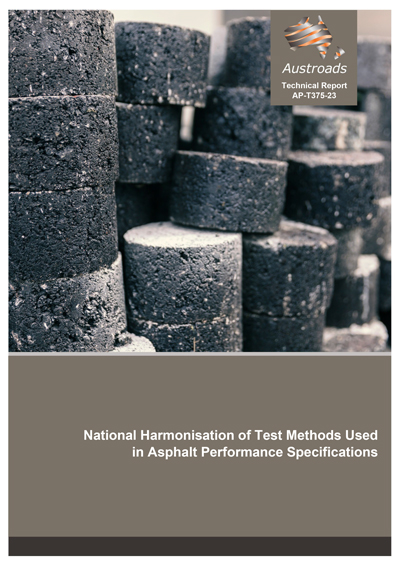Pavement

- Publication no: AP-T375-23
- ISBN: 978-1-922700-98-8
- Published: 16 August 2023
- PDF (free) Download
This report documents the delivery of the first component of a new Austroads performance-related asphalt specification framework. This included the development of several new test methods and updating a number of existing test methods for use in future performance specifications. The project also investigated the ability of small-scale laboratory wheel tracking devices to assess the deformation resistance of heavy-duty asphalt mixes for use in severe environments. The literature review and laboratory testing undertaken identified several limitations with the current Austroads wheel tracking test method and hence it was recommended to investigate alternative permanent deformation resistance test methods for heavy-duty mixes in severe environments.
A review of available test data identified the need for road jurisdictions to develop performance limits of their locally manufactured asphalt mixes that can be included in future performance-related asphalt specifications. Based on the work undertaken to date, it is recommended that the subsequent stages of this project focus on:
- establishing an agreed set of indicative performance limits for the properties included in the concept specification framework previously developed
- assessing the impact of variability in the manufacturing and placement process and test methods on the performance properties of asphalt mixes in the laboratory
- preparing a harmonised performance-related asphalt specification document, including any guide notes that may be required.
Watch a webinar for a detailed overview of the report.
- Summary
- 1. Introduction
- 1.1 Purpose
- 1.2 Scope
- 1.3 Methodology
- 2. Asphalt Laboratory Conditioning Methods
- 2.1 Background
- 2.2 Factors Affecting Asphalt Ageing
- 2.3 Review of Asphalt Conditioning Protocols
- 2.3.1 Factors Affecting Asphalt Laboratory Conditioning Protocols
- 2.4 Standard Laboratory Conditioning Procedures
- 2.4.1 Conditioning Procedures Used in Australia
- 2.4.2 Conditioning Procedures Used in Europe
- 2.4.3 Conditioning Procedures Used in the USA
- 2.4.4 Comparison Between Different Standard Conditioning Procedures
- 2.5 Summary of Findings
- 3. New Gyratory Compaction Test Method
- 3.1 Background
- 3.2 New Austroads Gyratory Compaction Test Method
- 3.3 Effect of Vertical Stress and Gyratory Angle on Asphalt Specimen Properties
- 3.4 Effect of Mould Size on Asphalt Specimen Properties
- 3.4.1 Effect of Mould Size on the Compacted Density of Asphalt Specimens
- 3.4.2 Effect of Mould Size on the Homogeneity of Air Voids in Gyratory Compacted Asphalt Specimens
- 3.4.3 Effect of Mould Size on the Tensile Strength Ratio of Compacted Asphalt Specimens
- 3.5 Summary of Findings
- 4. New Laboratory Permeability Test Method
- 4.1 Background
- 4.2 Laboratory Permeability Tests
- 4.2.1 International Test Methods
- 4.2.2 Australian and New Zealand Test Methods
- 4.3 New Austroads Test Method ATM 238
- 5. New Verification Procedure for ATM 274
- 5.1 Background
- 5.2 Testing Equipment
- 5.3 Test Configuration
- 5.4 Reference Beam Properties
- 5.5 Modulus Test Verification
- 5.6 Fatigue Test Verification
- 5.7 New Austroads Test Method ATM 239
- 6. Asphalt Permanent Deformation Resistance
- 6.1 Background
- 6.2 Laboratory-scale Wheel Tracking Devices and Test Methods
- 6.3 Link between Laboratory Wheel Tracking Results and Field Performance
- 6.4 Ability of ATM 231 to Rank the Rutting Performance of Different Asphalt Mixes in the Laboratory
- 6.5 Influence of Test Parameters on Asphalt Deformation Measured in the Laboratory
- 6.5.1 Applied Load and Contact Stress
- 6.5.2 Test Temperature
- 6.5.3 Specimen Confinement
- 6.5.4 Specimen Compaction Method
- 6.5.5 Air Void Content
- 6.6 Laboratory Investigation
- 6.6.1 Standard Wheel Tracking Testing
- 6.6.2 Varying the Level of Lateral Confinement in the Wheel Tracking Test
- 6.6.3 Increasing the Test Temperature and Number of Load Passes in the Standard Wheel Tracking Test
- 6.7 Summary of Findings and Recommendations
- 7. Amendments to Austroads Test Methods
- 7.1 ATM 232 Stripping Potential of Asphalt: Tensile Strength Ratio
- 7.2 ATM 274 Characterisation of Flexural Stiffness and Fatigue Performance of Bituminous Mixes
- 7.3 ATM 231 Deformation Resistance of Asphalt Mixtures by the Wheel Tracking Test
- 7.4 ATM 210 Verification Procedure for a Wheel Tracking Test Device
- 8. Available Asphalt Laboratory Performance Data
- 8.1 Modulus and Fatigue Performance Test Data
- 8.1.1 Available Flexural Modulus Test Data
- 8.1.2 Available Fatigue Resistance Test Data
- 8.1.3 Summary of Findings and Recommendations
- 8.2 Deformation Resistance Test Data
- 8.2.1 Available Wheel Tracking Test Data
- 8.2.2 Summary of Findings and Recommendations
- 8.1 Modulus and Fatigue Performance Test Data
- 9. Conclusions and Recommendations
- 9.1 Key Findings and Recommendations
- 9.2 Proposed Way Forward and Recommendations for Further Research
- References
- Appendix A AfPA Gyratory Compaction Position Paper
- Appendix B Available Performance Test Results
- B.1 Flexural Modulus and Fatigue Test Results at 20 C
- B.2 Rutting Test Results
